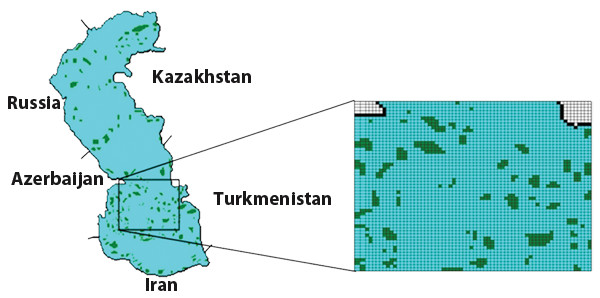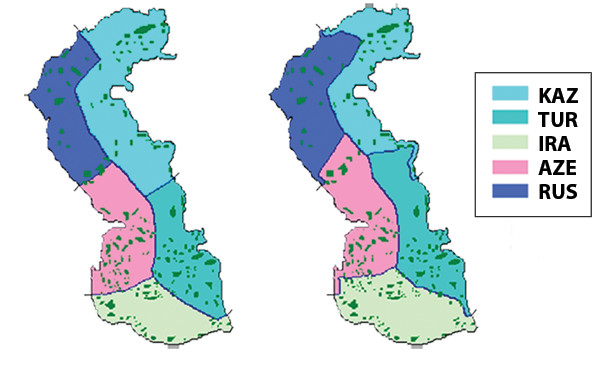
by Timothy Oleson Tuesday, October 15, 2013

A digitized map of the Caspian Sea used in the Negotiation Support System showing the locations of proven oil and gas deposits (green). Courtesy of Kaveh Madani

Sample outputs (optimum nautical boundaries) created by the NSS follow the stipulation that either each portion of the sea is allotted to the country to which it is physically closest (left), or that each country receives an equal areal portion (i.e., 20 percent) of the sea (right). Courtesy of Kaveh Madani
To supplement their efforts at modeling the Caspian conflict using game theory and, potentially, to aid the five littoral countries as they continue to negotiate over how to govern and apportion the sea and its resources, Kaveh Madani, a civil engineer at the University of Central Florida, and his colleagues have developed a computer model dubbed the Caspian Sea Negotiation Support System (NSS).
In the model, the sea surface is gridded into thousands of cells of equal area, but with monetary values that vary based on the unequal distribution of known oil and gas reserves and environmental resources. Given a stipulated division scenario — whether it demands that each country receive an equal areal share of the sea surface, an equal monetary share of the total resources, or that the sea be divided (unequally) according to the UN Convention on the Law of the Sea — the NSS’s algorithm assigns each grid cell to one country, essentially determining feasible nautical boundaries as well as the resulting share of resources and their economic value for each. “We try to find the optimal boundaries,” Madani says, so that the sea is distributed as efficiently and fairly as possible, and so that each country has areas (along their coastlines, for example) that are strategic to it.
The NSS is still in development, but so far, it has “proved clearly that there is a mismatch between the areal and utility shares” that the countries will receive, Madani says. Just because you might get 20 percent of the sea doesn’t mean you’ll get 20 percent of the resources, for example, he notes, because “we’re dealing with a system in which resources are not distributed evenly.”
The NSS has also highlighted another mismatch: that between the value of the tremendous energy sources available and of environmental resources like fish stocks, which have historically been a financial boon for the region. Given the rapid economic development and sustained competition over the sea’s energy resources, Madani says he fears that ongoing environmental degradation of the Caspian Sea will only worsen.
© 2008-2021. All rights reserved. Any copying, redistribution or retransmission of any of the contents of this service without the expressed written permission of the American Geosciences Institute is expressly prohibited. Click here for all copyright requests.